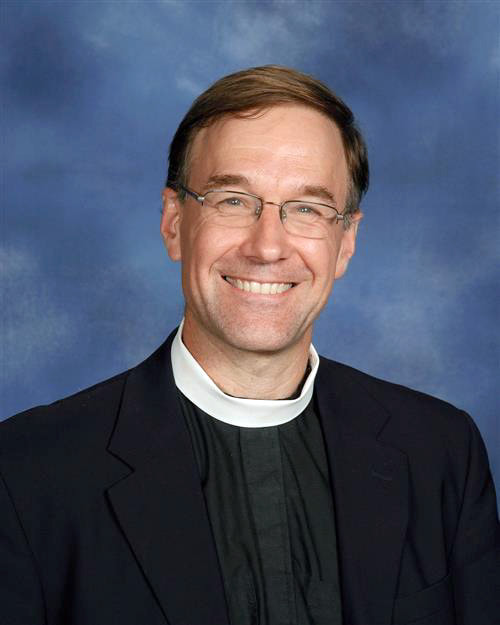|
For Christian people, today is the best day of the entire year. We can and should celebrate the resurrection every day wherever we are. We sacramentally celebrate the resurrection here at Church every Sunday.
But Easter morning is special. More even than other days, today we celebrate the good news of great joy that Christ rose from the dead, that Christ is alive, that life wins out over death, that love wins out over hatred and indifference, that this is God’s world, that we are all heading for eternal life. Can I get an Alleluia? But to appreciate just how good that good news is, we need to remember the alternative, what life is like without resurrection. Some of you will know the Stations of the Cross. As we walk the Stations here at Saint David, we work our way around the sanctuary, pausing at each of the wooden carvings of Christ, telling Christ’s story from his condemnation by Pilate in Station one through his death and burial in Station fourteen. At the very end of the final station, we hear these words from the Gospel of Mark: Joseph “wrapped [Jesus’] body in the linen cloth, and laid it in a tomb that had been hewn out of the rock. He then rolled a stone against the door of the tomb” (15:46). The end. That’s not the end of Jesus’ story, of course. But that’s where the Stations of the Cross end, with death, before resurrection. As I walked the Stations over the last couple of weeks, I was struck by the finality of that last line. Jesus was dead and buried. The tomb was sealed. And not just sealed. Sealed with a large stone, as if to emphasize just how sealed it was. At that moment, Jesus’ story certainly seems over. And if that were the end of Jesus’ story, his story would be a tragedy pure and simple, the story of yet another good person killed unjustly. We all know that story. We read that story in the newspapers virtually every day. Tragedy is how Jesus’ disciples understood his story in the hours and days immediately after his crucifixion and before his resurrection. The disciples were lost, and they were afraid, and they were stricken with grief. That’s what life and death look like without resurrection. In those hours and days immediately after the crucifixion, the women were the bravest and most faithful of the disciples. But when Mary Magdalene and another Mary and Salome go to Jesus’ tomb in our reading for this morning, they are NOT expecting resurrection. They go to the tomb so that they can care for Jesus’ dead body. And these sad, faithful women fear they can’t even to do that. They fear that Joseph’s stone is effectively immoveable. They fear that they won’t even be able to express their love and dedication to their dead friend. That’s what life and death look like without resurrection. If this were the end of Jesus’ story, as the women feared, then, when faced with the death of someone we love, all we could do is grieve helplessly. But we are here this morning because that was NOT the end of Jesus’ story. When the women got to the tomb, the stone was rolled back. The tomb was empty. An angelic messenger showed up, and dispatched them to the disciples with the incredible news that Jesus was raised, that Jesus was on the move, that they could continue to follow the one who was their friend and also their risen Lord. Life, it turns out, climaxes with resurrection. That is a LOT to take in! The immediate reaction of the women is terror and amazement. The news seemed too good to be true. The news seemed too good to be true until Jesus himself appeared to them, and confirmed the good news that he lived, that he had defeated death on our behalf. And then Jesus sent the women and the other disciples out to share that “sacred and imperishable proclamation of eternal salvation” to all the world, “from east to west.” Two thousand years later, we are in about the same spot as the women on that first Easter. Faced with the tragedies of our world, it is easy to get discouraged, to feel helpless, to grieve all that is wrong, and stop there. Then we hear the good news of Christ’s resurrection. And we hear the command to share that good news with a hurting world. But sometimes that good news can seem too good to be true even now. Sometimes we are filled with terror or amazement at the things that happen. Sometimes we feel the temptation to keep silence and say nothing to anyone. But the good news of resurrection is true. It is the most important truth in all the world. Death could not hold Christ. The tomb was empty that day. And still today Christ is alive and on the move in our world, going on ahead of us, leading us, however imperceptibly, towards God and life and love. This morning, we gather to celebrate that good news, to celebrate Christ’s resurrection, Christ’s victory, the ongoing presence of Christ in our lives and in our world. That’s what makes this the best day of the whole year. And, we need to share the good news of Christ’s victory. Because too many people all around us remain stuck in a story that doesn’t include resurrection, that seems to end at a tomb with a big stone in front of it. They need to hear about the empty tomb and the life of Christ, and in Christ, that keeps on going, now and always. Back on Ash Wednesday, at the beginning of Lent in the middle of February, many of us were anointed with ashes, and we heard the grim words, “Remember you are dust, and to dust you will return.” It was a reminder that we will all die, that the tomb is part of our story. But not the end of our story. The Ash Wednesday reminder of our mortality is incomplete without Easter, without the good news of this morning, the good news of the empty tomb and the stone that was rolled away, the good news of resurrection, the good news that Christ died and rose again so that we, too, might live. So today, immediately following communion, I invite you to linger for a moment at the altar rail so that we can finish what we began on Ash Wednesday. I will anoint you with holy oil and bless you with the good news of this morning, the true end of our story. “God’s love is stronger than death, and to God’s love you are returning.” That is a statement about our future, when we will rest eternally in God’s love. And it is a statement about our present, too. God’s love is stronger than death, even now. We are in the process of returning to God’s love, even now. Christ is alive, and with us, always. God’s love is revealed in our risen Lord, always. God is at work bringing about resurrection and new life, always. That is the good news of Easter, good news that is well worth sharing. Thanks be to God. Alleluia, alleluia!
2 Comments
|
Rector
Rev. Dr. Harvey Hill Third Order Franciscan Archives
July 2024
Categories |


 RSS Feed
RSS Feed
